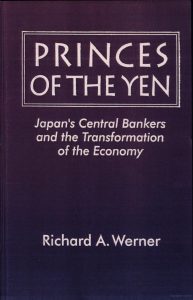Documentary based on Professor Richard Werner’s book: ‘Princes of the Yen’
An older City friend of mine recently encouraged me to watch this video; I only wish I’d seen the first part of it much earlier, as I had traded my way through most of the convolutions and revolutions he mentions later on. The focus is very much on the economy and state structures that have dominated post World War II Japan, but I have felt that these are worth listening to and learning from as that country is at the forefront of economic thinking and the reality that many more will be forced to face soon. Please remember that this is one man’s opinion and some will consider his ideas controversial.
Werner received a first class BSc. from the London School of Economics in 1989 and then followed an academic career until 2016 when, based in Winchester, he founded the Hampshire Community Bank. Clips in the documentary include some of his many media interviews from times when he was based in Japan.
In fact, there are lots of great clips of Japan illustrating events and institutions as they developed post 1941 Pearl Harbour, the dropping of the atom bomb, and the American occupation based in Yokohama. He explains the ‘zaibatsu’ (capitalist elite), the selection of Mr Araki as the first post-war head of the central bank, the War Economy System and the Liberal Democratic Party’s stranglehold on politics. This ensured that the Ministry of Finance was all-powerful with the Bank of Japan reporting to it, ‘window guidance’ deciding which consumer goods sectors were to be granted credit.
the ‘zaibatsu’ (capitalist elite), the selection of Mr Araki as the first post-war head of the central bank, the War Economy System and the Liberal Democratic Party’s stranglehold on politics. This ensured that the Ministry of Finance was all-powerful with the Bank of Japan reporting to it, ‘window guidance’ deciding which consumer goods sectors were to be granted credit.
Financial deregulation in the 1980s fanned leverage, speculation in equities and especially real estate – so that at one point the land value of Japan was four times that of the USA. Up until here the Japanese authorities aimed to give their nation every advantage to grow their economy and increase exports. For years Western nations complained of the ultra-low interest rates they employed and the (in their view) excessive weakness of the yen. All this stopped suddenly (by decree that window guidance would end) in 1990; the key Nikkei 225 index fell by 32% that year.
Today Japan is once again leading the way with a new metric: population decline. In the year to October 2023 there were 837,000 fewer Japanese nationals – meaning the country lost nearly 100 natives per hour. Simultaneously foreign residents hit a record high of 3.2 million, and the overall population shrank to 124.3 million. Births in 2023 were at a record low (based on comparable records to the 1950s) and the average household was just 2.21 people – and expected to drop below 2 by 2033.
Some call this a long-term demographic crisis; it’s not, it’s the new reality.
Tags: Central banks, FX, Japan, Monetary Policy
The views and opinions expressed on the STA’s blog do not necessarily represent those of the Society of Technical Analysts (the “STA”), or of any officer, director or member of the STA. The STA makes no representations as to the accuracy, completeness, or reliability of any information on the blog or found by following any link on blog, and none of the STA, STA Administrative Services or any current or past executive board members are liable for any errors, omissions, or delays in this information or any losses, injuries, or damages arising from its display or use. None of the information on the STA’s blog constitutes investment advice.
Latest Posts
- Living in a land of large numbers: How to get a grip July 24, 2024
- Debate with ACI UK, The Broker Club & The Commodities Trading Club: Forecasts for the second half – plus marks for first half July 10, 2024
- Retail traders embrace volatility: Zero-day options and penny stocks on today’s menu June 24, 2024
- STA members and their guests get a dose of hypnotherapy June 12, 2024
- ‘And it’s a goal! Again’ Rectangles, corsets and straightjackets May 28, 2024




















Latest Comments